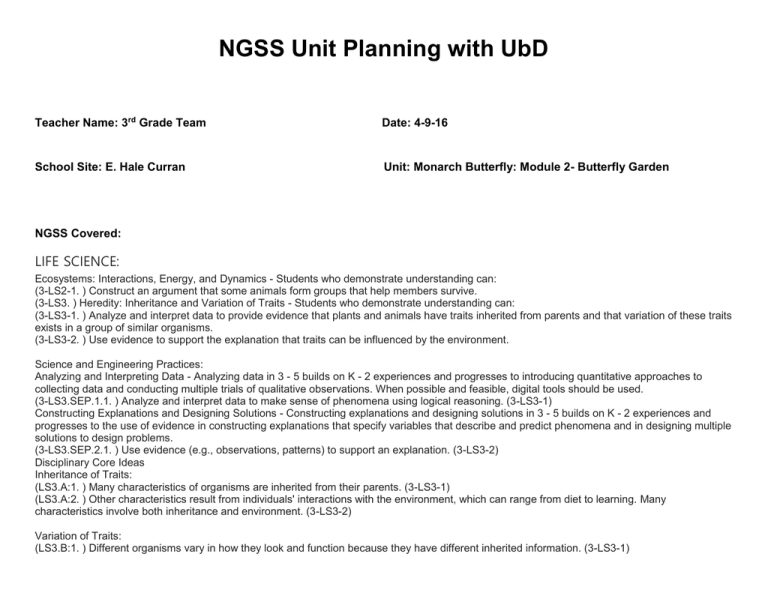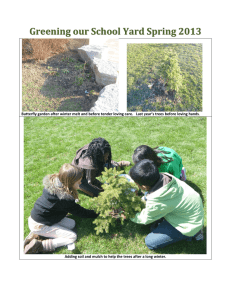NGSS Unit Planning with UbD
advertisement

NGSS Unit Planning with UbD Teacher Name: 3rd Grade Team Date: 4-9-16 School Site: E. Hale Curran Unit: Monarch Butterfly: Module 2- Butterfly Garden NGSS Covered: LIFE SCIENCE: Ecosystems: Interactions, Energy, and Dynamics - Students who demonstrate understanding can: (3-LS2-1. ) Construct an argument that some animals form groups that help members survive. (3-LS3. ) Heredity: Inheritance and Variation of Traits - Students who demonstrate understanding can: (3-LS3-1. ) Analyze and interpret data to provide evidence that plants and animals have traits inherited from parents and that variation of these traits exists in a group of similar organisms. (3-LS3-2. ) Use evidence to support the explanation that traits can be influenced by the environment. Science and Engineering Practices: Analyzing and Interpreting Data - Analyzing data in 3 - 5 builds on K - 2 experiences and progresses to introducing quantitative approaches to collecting data and conducting multiple trials of qualitative observations. When possible and feasible, digital tools should be used. (3-LS3.SEP.1.1. ) Analyze and interpret data to make sense of phenomena using logical reasoning. (3-LS3-1) Constructing Explanations and Designing Solutions - Constructing explanations and designing solutions in 3 - 5 builds on K - 2 experiences and progresses to the use of evidence in constructing explanations that specify variables that describe and predict phenomena and in designing multiple solutions to design problems. (3-LS3.SEP.2.1. ) Use evidence (e.g., observations, patterns) to support an explanation. (3-LS3-2) Disciplinary Core Ideas Inheritance of Traits: (LS3.A:1. ) Many characteristics of organisms are inherited from their parents. (3-LS3-1) (LS3.A:2. ) Other characteristics result from individuals' interactions with the environment, which can range from diet to learning. Many characteristics involve both inheritance and environment. (3-LS3-2) Variation of Traits: (LS3.B:1. ) Different organisms vary in how they look and function because they have different inherited information. (3-LS3-1) (LS3.B:2. ) The environment also affects the traits that an organism develops. (3-LS3-2) Ecosystem Dynamics, Functioning, and Resilience: (LS2.C:1. ) When the environment changes in ways that affect a place's physical characteristics, temperature, or availability of resources, some organisms survive and reproduce, others move to new locations, yet others move into the transformed environment, and some die. (secondary to 3LS4-4) Natural Selection (LS4.B:1. ) Sometimes the differences in characteristics between individuals of the same species provide advantages in surviving, finding mates, and reproducing. (3-LS4-2) Adaptation (LS4.C:1. ) For any particular environment, some kinds of organisms survive well, some survive less well, and some cannot survive at all. (3-LS4-3) Biodiversity and Humans (LS4.D:1. ) Populations live in a variety of habitats, and change in those habitats affects the organisms living there. (3-LS4-4) Crosscutting Concepts Patterns (3-LS3.CC.1.1. ) Similarities and differences in patterns can be used to sort and classify natural phenomena. (3-LS3-1) Cause and Effect (3-LS3.CC.2.1. ) Cause and effect relationships are routinely identified and used to explain change. (3-LS3-2) Systems and System Models (3-LS4.CC.3.1. ) A system can be described in terms of its components and their interactions. (3-LS4-4) (3-LS4. ) Biological Evolution: Unity and Diversity - Students who demonstrate understanding can: (3-LS4-2. ) Use evidence to construct an explanation for how the variations in characteristics among individuals of the same species may provide advantages in surviving, finding mates, and reproducing. (3-LS4-3. ) Construct an argument with evidence that in a particular habitat some organisms can survive well, some survive less well, and some cannot survive at all. (3-LS4-4. ) Make a claim about the merit of a solution to a problem caused when the environment changes and the types of plants and animals that live there may change. CCSS ELA Covered: Reading: Informational Text: RI 3.5- Use text features and search tools (e.g., key words, sidebars, hyperlinks) to locate information relevant to a given topic efficiently. RI. 3.7- Use information gained from illustrations (e.g., maps, photographs) and the words in a text to demonstrate understanding of the text (e.g., where, when, why, and how key events occur). Writing: W.3.2- Write informative/explanatory texts to examine a topic and convey ideas and information clearly. W.3.7- Conduct short research projects that build knowledge about a topic. CCSS Mathematics Covered: Operations and Algebraic Thinking: Represent and solve problems involving multiplication and division. (3.OA.1. ) Interpret products of whole numbers, e.g., interpret 5 +ù 7 as the total number of objects in 5 groups of 7 objects each For example, describe a context in which a total number of objects can be expressed as 5 +ù 7. Understand properties of multiplication and the relationship between multiplication and division. (3.OA.5. ) Apply properties of operations as strategies to multiply and divide. Examples: If 6 +ù 4 = 24 is known, then 4 +ù 6 = 24 is also known. (Commutative property of multiplication.) 3 +ù 5 +ù 2 can be found by 3 +ù 5 = 15, then 15 +ù 2 = 30, or by 5 +ù 2 = 10, then 3 +ù 10 = 30. (Associative property of multiplication.) Knowing that 8 +ù 5 = 40 and 8 +ù 2 = 16, one can find 8 +ù 7 as 8 +ù (5 + 2) = (8 +ù 5) + (8 +ù 2) = 40 + 16 = 56. (Distributive property.) Measurement and Data Represent and interpret data: (3.MD.4. ) Generate measurement data by measuring lengths using rulers marked with halves and fourths of an inch. Show the data by making a line plot, where the horizontal scale is marked off in appropriate unitsGÇö whole numbers, halves, or quarters. Geometric measurement: understand concepts of area and relate area to multiplication and to addition. Recognize area as an attribute of plane figures and understand concepts of area measurement. (3.MD.5.a. ) A square with side length 1 unit, called GÇ£a unit square,GÇ¥ is said to have GÇ£one square unitGÇ¥ of area, and can be used to measure area. 3.MD.5.b. ) A plane figure which can be covered without gaps or overlaps by n unit squares is said to have an area of n square units. (3.MD.6. ) Measure areas by counting unit squares (square cm, square m, square in, square ft, and improvised units). Relate area to the operations of multiplication and addition. (3.MD.7.a. ) Find the area of a rectangle with whole-number side lengths by tiling it, and show that the area is the same as would be found by multiplying the side lengths. (3.MD.7.b. ) Multiply side lengths to find areas of rectangles with whole-number side lengths in the context of solving real world and mathematical problems, and represent whole-number products as rectangular areas in mathematical reasoning. (3.MD.7.c. ) Use tiling to show in a concrete case that the area of a rectangle with whole-number side lengths a and b + c is the sum of a +ù b and a +ù c. Use area models to represent the distributive property in mathematical reasoning. (3.MD.7.d. ) Recognize area as additive. Find areas of rectilinear figures by decomposing them into non-overlapping rectangles and adding the areas of the non-overlapping parts, applying this technique to solve real world problems. Note: This module should take about 10 to 14 days Understanding by Design NGSS Unit Plan Stage 1: Desired Results Understand Essential Question(s) All living things are made up of parts that have specific functions. People acting individually and/or as groups influence the environment. Living things depend on their habitat to meet their basic needs. 1. How can people help the Monarch Butterfly migrate safely year to year? 2. Can the environment influence the traits of the monarch Butterfly? Stage 2: Evidence/Assess Know Do Students will understand how traits of plants and animals are affected by the environment. They will also learn how people can either help or hinder the survival of plants and animals and how this can relate directly back to the delicate balance between habitats and environmental influence. Students will create a blueprint for a butterfly garden. The blueprint will need to include dimensions for the garden's size as well as dimensions for a fence that will go around the garden. Additionally, they will need to include the plants they will use in the garden. Students must draw and label the plants they will include, such as milkweed, butterfly bush, and other plants that are beneficial to the monarch butterfly. The blueprint will need to be drawn to scale so they know exactly how many plants they will need and how much space they need between each plant. Vocabulary: traits, environment, influence Stage 3: Learning Plan How Engage (1 day): Show students the video on Defined STEM explaining the Butterfly Garden Blueprint. Explain the purpose of this module. Then have students work in partners or teams and have them write down the essential questions. Give them time to discuss the two questions and their thoughts about those questions. Have them jot down those thoughts for a discussion later in the module. A suggestion would be to show students examples of blueprints and scale drawings. There are some added to the Monarch Butterfly Symbaloo page for students to use. Explore (2-4 days): Teams or partners will use research from their previous module as well as new research to help plan their Butterfly Garden Blueprint. They can use the resources on the Symbaloo page to help them determine what their garden should look like as well as the scale they will use. They should come up with a rough plan as well as the scale. They need to include the type of plants that would be included in the garden that are beneficial for Monarchs. Explain (2-4 days): Teams or partners will create their scale drawing of their Butterfly Garden Blueprint. Their blueprint should include the scale they are using, accurate drawings of plants and labels for the plants. Elaborate (2-3 days): Teams or partners will write a rationale about their butterfly garden. This relates back to the first essential question. Their rationale should include why people should create a butterfly garden for the Monarch. Will this help them get off the endangered list? They should also include why they chose the plants they did. How are they good for the Monarch? A suggestion would be to have them use some form of multimedia like a PowerPoint, Haiku Deck, or iMovie to explain their rationale. Evaluate (2-4 days): Teams or partners will present their Butterfly Garden Blueprint and rationale to another team or partners. Each team will critique the other teams’ or partners’ blueprint and rationale. Give teams or partners time to revise before then presenting to the class. When presentations are done have a class discussion on the essential questions. Stage 4: Transfer Knowledge Transfer Crosscutting Concepts: Cause an Effect: Cause and effect relationships are routinely identified and used to explain change Patterns: Similarities and differences in patterns can be used to classify natural phenomena Scale, Proportion, and Quantity: Observable phenomena exist from very short to very long time periods. Students will see how cause and effect, patterns and scale, proportion, and quantity are interwoven throughout life science as well as other subjects like math and social studies.

